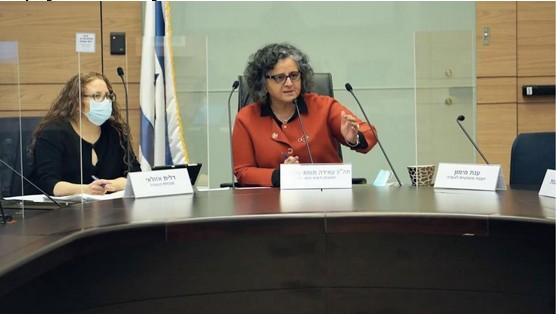The Committee on the Status of Women and Gender Equality, chaired by MK Aida Touma-Sliman (Hadash – Joint List), held a special debate on Monday on the topic of technological violence. MK Touma-Sliman said at the start of the debate that the issue had received little attention in terms of legislation, citing the video clips law as an example. “I understood that we, the legislators, aren’t able to keep up with the digital world and social media. We haven’t been able to provide a response for protection of women and children who are victims of bullying and technological attacks on social media.”

The debate on technological violence at the Committee on the Status of Women and Gender Equality, chaired by MK Aida Touma-Sliman (Photo: Knesset)
Adv. Efrat Fudem of the College of Management’s Faculty of Law: “We have not discovered a new set of power relations. Violence is employed as a show of force. This need may be translated into physical and psychological violence, which could take lives. Reality has shown that we do not have enough tools to help women who are harmed by various aspects of technological violence. The issue has to be acknowledged. It’s important to name it and define what it includes. There are multigenerational and multicultural aspects that vary from one population to another.”
According a victim of technological violence, Maya Lee Levy, “For a year and a half I suffered from very severe technological violence. I didn’t know where to turn and what to do. Offensive videos were made about me and distributed. I was persecuted by one person for a year and a half. When I went to the police, I felt that there was nothing to do.” She said tearfully: “I was told, ‘it’s online, there’s nothing to do with your complaint.’ I came to the conclusion that if I didn’t do something myself, there wouldn’t be anyone to protect me. If I report it to TikTok or Instagram, and they block him—so what, he’ll be able to open a new profile. I am here to raise the issue, because I know that there are other people being harmed on a daily basis.”
Dr. Michal Dolev-Cohen, senior lecturer of cyberpsychology at Oranim Academic College of Education: “In a study we performed, we found that one of three adolescents engage in sexting (online messaging of a sexual nature), and one of four in religious society. Afterwards we see extortion of a sexual nature or ‘revenge porn,’ if someone breaks up with her boyfriend. Today it can happen to any young woman. Even when the parents are very involved, then the children don’t tell them.” Maram Sliman of I’lam–Arab Center for Media Freedom, Development and Research, added: “If we take Arab-Bedouin society in the Negev, we have received complaints from women and teenage girls who were photographed at bus stops; someone was photographed with her brother and the picture was distributed making it look like there was something beyond [what it actually was]. People distribute the photos and threaten. Things like this can reach the point of sexual or financial extortion. The social media platforms aren’t aware of the context of a particular image in a social context. We met with the management of TikTok and raised the need to address the context of the post. They set up a system that makes it possible for a civil society organization to complain about content that is offensive even though it doesn’t look offensive. There is freedom of expression and there is violence, and it’s necessary to distinguish between the two.”
Adv. Gili Varon of WIZO presented a proposed bill for prevention of technological violence that she had drafted together with Adv. Fudem, with the assistance of students from legal clinics, saying that “this is a widespread phenomenon. It refers to any technological platform that has become a weapon in the hands of those who have the power to destroy lives. The progress of technology has outstripped legislation that was enacted 20 years ago.” Adv. Varon wrote that the purpose of the law was to prohibit technological violence in order to protect the dignity, liberty, privacy and safety of people, with the aim of advancing gender equality. Committee Chair MK Touma-Sliman said: “The bill you’ve prepared includes and addresses many of the points you mentioned, and we in the committee will be glad to advance it.”
Dr. Nava Cohen-Avigdor of the 105 hotline, a national call center that accepts queries and reports from the public and provides professional responses to harm, violence, and crime aimed at children and adolescents in cyberspace, affirmed: “The law in the physical space also applies to cyberspace. There is a difficulty in enforcement. There are civil and also criminal offenses that are committed. From February 2018 until today, there have been reports at the 105 hotline of over 36,000 cases of abuse of minors online. Virtual rape, which was mentioned here, is rape for all intents and purposes.”
“The speed of removal of offensive content is critical. It was mentioned here that in one society, a certain image may not be offensive at all, but in another, traditional society, being photographed without a head covering could lead to harm or even murder by relatives or the father. Not everything has to be the subject of a legal debate with the technology companies over the question whether it’s offensive or not. Seventy percent of the offenders who harm minors are minors themselves,” said Dr. Cohen-Avigdor.


